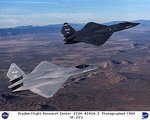davparlr
Senior Master Sergeant
I have heard of some bombers outurning fighters and with the big wing of the B-2 it could possibly be done at some combination of airspeed and altitude. Some whiz could probably calculate some turn rates. I find it hard to believe that the B-2 would be trying to turn with a figter, or even get close to one. It is expensive!


